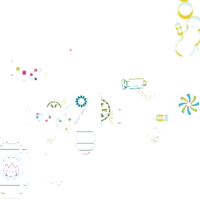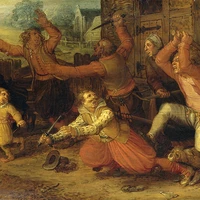Levers for Competitive Power
What are the levers for organizational success? What conditions determine competitive power? Recent trends include the learning organization, knowledge management, core competencies and performance management. Are these lasting changes or hypes that will fade away?
Some trends seem to survive. The flattening of organizational hierarchy and the tendency to delegate tasks and responsibilities are examples of this. But there are more changes that go beyond the hype of the day:
|
|
|
|
|
|
|
|
|
|
This is an interesting list but also very arbitrary. Some readers might disagree with this selection, others might want to add items. Another important drawback is its lack of consistency; it looks like a kind of laundry list, with no integration. What is the underlying pattern? What are the more fundamental factors? Do we need new paradigms and 'breakthroughs' in organizational theory like transformation management and chaos theory, to solve these questions?
Historical Perspective
What has proved its value over centuries may give us something to hold on in modern times as well. A brief description of the historical development of organizations will clarify the concepts useful for catching the most crucial aspects of organizational change. Their implications for modern organizations will then be described.
A good starting point for our discussion are army organizations, which are among the world’s oldest large scale organizations.
Early Army Organizations
Let me first introduce a man who was an authoritative pioneer in his own time, Prince Maurice of Orange (1567-1625). In the period between 1590 and 1600 Maurice introduced a number of innovative organizational principles. His central problem was the disciplining of a riotous soldiery against the overwhelming force of the Spanish troops in the Netherlands. Below are three examples of his interventions:
- The common formation in the 16th century was the so-called Spanish Brigade: 50 men across and 50 deep, it comprised a square formation, completely filled with troops. So most of these men couldn't even use their pikes. Their only function was to provide moral and physical back-up (by pushing!) for the front ranks. Maurice succeeded in greatly increasing the performance of the available troops by introducing a shallow formation. This change in battle array necessitated major psychological changes, because the earlier support of the mass was lost and vulnerability was increased. So, better training and tighter discipline were required which resulted in increasing personal effort and self-confidence.
- Maurice also enhanced self-confidence by steeping the soldiers in a thorough training regimen. For example, the use of the musket was based on a precise 'motion-study' of every handling procedure. The 43 (!) separate actions were classified in a series of functional acts. Special commands were developed for these acts and endless practice resulted in independent and fast execution.
- Short, clear, and most of all standardized commands were introduced. This style of command required silence from the troop, which was something new. Not only did the troops have to be quiet, they also had to learn how to line up in fixed places in organized ranks and files, where before they had been a motley, swarming horde.
In all three examples we see a mutually enhancing interaction of increased external discipline and growing individual discipline in terms of self-control and self-confidence. Maurice's military genius sensed exactly where earlier army reforms had failed. He gave shape to an interaction between both mechanisms. This mutual enhancement, consistently maintained over long periods of training, resulted in a level of strength never before attained. Victory upon victory was the result. These successes were so impressive that by 1630 most European states had adopted Maurice's reforms.
More discipline and self-organization
Maurice achieved increased tactical flexibility in replacing the massive and inflexible square by a shallow formation. However, the disappearance of the massive back-up demanded a different type of soldier: one with more discipline and self-confidence, the ability to react instantly to orders, and the ability to retain group cohesion in spite of increased mobility.
The French colonel Ardant du Picq wrote his “Etude sur le combat” in 1868. In his days, the first quick-firing arms were introduced. To lessen his troops’ vulnerability, he pleaded for an open battle array. Just as in Maurice’s situation, this change demanded a different attitude from the soldiers. Ardant du Picq wanted well-trained, relatively small formations, and the result was platoons. The soldiers in these formations had to make good teams, but they also needed their own responsibility to act. To be able to use this responsibility, autonomous thinking and action became important and had to be practiced. Army organizations still wrestle with this problem. The basic question is: How detailed should central steering and command be versus how much freedom for local commanders, given the turbulent, unpredictable events on the battlefield.
Since Napoleon defeated the Prusian Army in 1806, German army command has been geared to this question. This resulted in the so-called ‘Auftragspolitik’ (Policy deployment) which was, in fact, a model of delegation. Von Moltke articulated this doctrine around 1860. In the German army the commanders, including the lowest ranks, were trained to solve their problems on the battlefield in the context of ‘worauf kommt es eigentlich an’ (the essence of the overall strategy).
This policy was linked deliberately to increasing the autonomy and the team spirit of small units under the turbulent circumstances of the battlefield.
Is not the steady continuity in this development from Maurice via Ardent du Picq to the ‘Auftragstaktik’ remarkable? During World War II the American army had not achieved this relatively high articulation of central command as well as autonomous action by local commanders. According to Dupuy (1977, p. 234-235) this accounted for the fact that, under all circumstances, American losses on the battlefield were 50% higher compared to those on the German side!
What we see here is the ongoing development of external means of control interacting with increased responsibility of individuals and small groups. Continuous discipline, formalization of behavior, strengthening of the hierarchy, growing solidarity and increased self-control – all coupled with expanding autonomy and responsibility - are the most important behavioral changes in this context.
Early capitalism and organizational innovation
Our industrial organizations went through similar developments. In his description of the emergence of the factory regime in the 19th century, Iterson (1992) writes: "The problems for the manufacturers were first of all problems of discipline and coordination. Factory regimes are based on a tangled combination of i) coercion (from the side of the manufacturers) and ii) willingness or motivation (on the workers' part)."
The discipline which seems so natural to us now, was not in evidence then. Iterson continues: "Bringing together men, women and children in one space implied the danger that people would get in each other's way, that arguments could erupt, sexual relations engaged in, or that they would 'overindulge' in other activities which were considered debauched (drinking) or idle (games).
Labourers also had to learn to control their language: subversive and obscene utterances also posed a threat to orderly labour and they were fined heavily. The same dangers also existed outside the factory, especially in combination with alcohol consumption. So conformance with the industrial regime was indirectly threatened by ‘corruption of the morals’ in their free time."
Orderly labour vs careless habits
This can be illustrated by the case of the earthenware industry of Josiah Wedgwood (1730-1790), a patriarchal factory owner in eighteenth century England. During his lifetime he transformed a local pottery, with a dozen men at work, into an international firm .
Wedgwood had two disciplinary adages: 'To make Artists ...(of)... mere men' and second 'to make such machines of Men as cannot err'.
First he concentrated all workers in one general workplace and held to his original 'scheme of keeping each workshop separate'. They were not allowed to wander around as they were used in the traditional workplaces. At the same time the work was organized in such a way that there was a smooth progression from the ware being painted, to being entered into the books to being stored'. (McKendrick, 1961, p. 32) By doing so he heightened the interdependence of his workers and at the same time gave them some task autonomy in separate places.
The traditional 'careless habits of the older generations' presented an ongoing problem in the development of high quality production for the new markets. Wedgwood had to fight a long local tradition of 'customs in common', in particular the 'stoppages for Wakes', (a local annual feast lasting several days and nights which were spent eating and drinking intemperately and 'fornicating'), but he also had to combat 'waste', 'idleness', 'the ban of drinking', 'working by the rule of thumb', 'inefficiency', 'arbitrariness', 'irregularity'.
The other side of the sometimes harsh regime of Wedgwood was that he offered his workers housing and care for the sick. That was not only out of economical reckoning. He felt a moral obligation. He wanted to improve his workmen's lot. He was concerned with civilizing their behaviour and educating them.
The remarks of Iterson that early factory regimes are based on a tangled combination of coercion (from the side of the entrepreneur) and willingness (on the workers part) are illustrated by these examples. Also we witness a process of trial and error towards an articulation of interdependency as well as autonomy in factory relations.
Organizational innovation as duality management
The skills of self-organization, which has been so highly praised and recommended recently, turn out to have a long history. If we cannot combine steering and control with self-organization and individual responsibility, the result will be increased rigidity. Apparently we have become more successful over the centuries in combining a wide array of steering and coordination mechanisms with bigger opportunities for autonomous functioning. We could even say that organizations that develop a more articulate balance, either by accident or thanks to the intuition of a talented leader, gain a substantial competitive advantage.
From this perspective, certain recent recommendations begin to gain importance: integration of functions and specialisms on levels that vary from autonomous task groups to business units; more focus on customers, both external and internal; a higher accountability of teams in terms of their results; a stronger orientation on the performance of units. We arrive at a sophisticated profile of both coordinating forces and self-organizing abilities. At all levels of the firm the tension balance between steering and self-organization becomes more outspoken.
External controls become internalized as self-discipline.
This higher level of self-organization enables more adequate steering. Gradually, the ability of organizations to deal with complexity improves. Some of our modern organizational designs are based on a high-tension balance of binding agents and autonomy. The central-decentral balance becomes more articulate – a strong centralism in a few critical areas can be combined with a high degree of autonomy of organizational units. A fine example are franchise organizations, they have developed a strong central steering and extensive unit autonomy.

In retrospect, we can describe the development over the centuries fairly clearly. For people directly involved, it often feels like a process of chaotic search and trial-and-error. Such disorientation is very much present in our times. This generates the following questions: Do the developments described above stand up in the context of recent developments? Does the changing tension balance between closer interdependencies and more autonomous units really points to organizational innovations and competitive advantage? If so, are we then able to indicate more specifically how competitive advantage can actually be mobilized?
Mobilizing competitive advantage
The development of more competitive organizations is based mainly on experience, on processes of trail and error. Prince Maurice and Josiah Wedgwood couldn’t care less about the balance between steering and self-organization. ‘Results!’ That was the name of the game. But Von Moltke’s army reforms express already a kind of conscousness of an overriding concept.
How can we make this an even more conscious process? What is the required “arsenal of steering and coordination mechanisms” and how can we combine it with increased autonomy and responsibility? In practice, we are becoming more and more sophisticated in this respect. A number of firms strengthen their duality and derive their competitive power from combinations of seemingly contradictory organizational principles: central and decentral , “loose and tight”, “small-in-large”.
The organization as a network
This organizational design of “small-in-large” as a network of relatively autonomous units, blends into network organizations in which units retain their autonomy as independent firms. Entrepreneurs find their strength primarily in organizing such networks. Take for example this situation: an ice hockey helmet is designed in Scandinavia, made ready for production and tuned to the demands of the global market in the United States, produces in Korea, and distributed from Japan. In itself such a network organization is not new. Miles (1989) already presents a series of examples of such network organizations in the fashion industry, the movie industry and publishing firms. The new element is the diffusion of this model to an increasing number of market sectors. Being the intermediary in such a network is not necessarily an independent function. Any of the participants can act as intermediary. It is, however, the crucial function. Companies that take on this function are sometimes given the derogatory name "hollow company". In my opinion it is appropriate to regard this as a high quality type of entrepreneurship. In this way we find a modern and catching variation of Schumpeter's (1954) definition of entrepreneurship as neue Kombinationen machen – 'creating new combinations'. (Note of the author in 2019: More recently this type of entrepreneurship refers to the socalled "platform-organization".)
Units in a process of steering and self-organization
Organizations are seen as changing networks of relations between units. These relations are best characterized in terms of balances between interdependence and autonomy and between steering and self-organization. Over the centuries we witness an increase in interdependence as well as autonomy. External controls become internalized as self-discipline. This higher level of self-organization and autonomy enables more adequate steering. Gradually, the ability of organizations to deal with complexity improves. This often provides a competitive edge.
The articulation of steering and self-organization is a process which shows a remarkable continuity. New types of organizations are not new. So-called new types of organizations are recent expressions of this same process.
This balancing act is an item of ongoing discussion for management. A major pitfall is to focus the discussion on either more steering and centralisation or more decentralization and autonomy. While it often should concern a more articulate balance of both central and decentral.
The concept of better steering and more self-organization applies not only to organizational innovation but also to change management. Let me describe in part 2 of this contribution some examples and approaches that are very popular but are also under some serious criticism (Beer, et al., 1992). Also I will provide an approach of change management more aligned with steering and self-organization.
Willem Mastenbroek, sociologist, founder of Holland Consulting Group, professor at the Faculty of Economics, Vrije Universiteit, Amsterdam.
LITERATURE
- Beer, M., Eisenstat, R.A., Spector, B. (1992) Why change programs don’t produce change. Harvard Business Review.
- Elias, N. (1939) Ueber den Prozess der Zivilisation. Soziogenetische und psychogenetische Untersuchungen. Basel: Haus zum Falken. English translation: (1994) The Civilizing Process. Oxford: Blackwell.
- Dupuy, T.N. (1977) A Genius for War, London: Mc Donald & Jane’s.
- Iterson, A. van (1992) Vader, raadgever en beschermer: Petrus Regout en zijn arbeiders 1834-1870. (Trans: Father, Counselor, and Patron: Petrus Regout and his Laborers.) Maastricht, Netherlands: Universitaire Pers.
- Iterson, A. Van, Mastenbroek, W., Newton, T. Smith, D. Eds. (2002) The Civilized Organization: Norbert Elias and the future of Organization Studies. Amsterdam/Philadelphia: John Benjamins Company.
- Mastenbroek, W.F.G. (1991) Organizations as parties in a system: a concept and its practical relevance. In: S.B. Bacharach (ed.). Research in the Sociology of Organizations. Greenwich, CT.: JAI Press, volume 9, pp. 49-78.
- Mastenbroek, W.F.G. (1993) Conflict Management and Organization Development. Chichester/NewYork: Wiley.
- McKendrick, N. (1961) Josiah Wedgwood and Factory Discipline. The Historical Journal, 4, 1.
- Miles, R.E. (1989) Adapting to technology and competition. California Management Review. Winter.
- Moltke, H. von (1988) Vortrage zur Militargeschichte, Band 9. (Trans: Lectures in Military History, Vol 9.) Herford/ Bonn, Germany: Mittler und Sohn.
- Schumpeter, J.A. (1954) Capitalism, Socialism and Democracy, 4th ed. London: George Allen & Unwin.
Gerelateerde artikelen

Organizational Innovation in Historical Perspective, part 2
Willem Mastenbroek

Organizational behavior in historical perspective 2
Willem Mastenbroek



Deel uw ervaringen op ManagementSite
Wij zijn altijd op zoek naar ervaringen uit de praktijk, wat werkt wel, wat niet.
SCHRIJF MEE >>
Als u 3 of meer artikelen per jaar schrijft, ontvangt u een gratis pro-abonnement twv €200,--